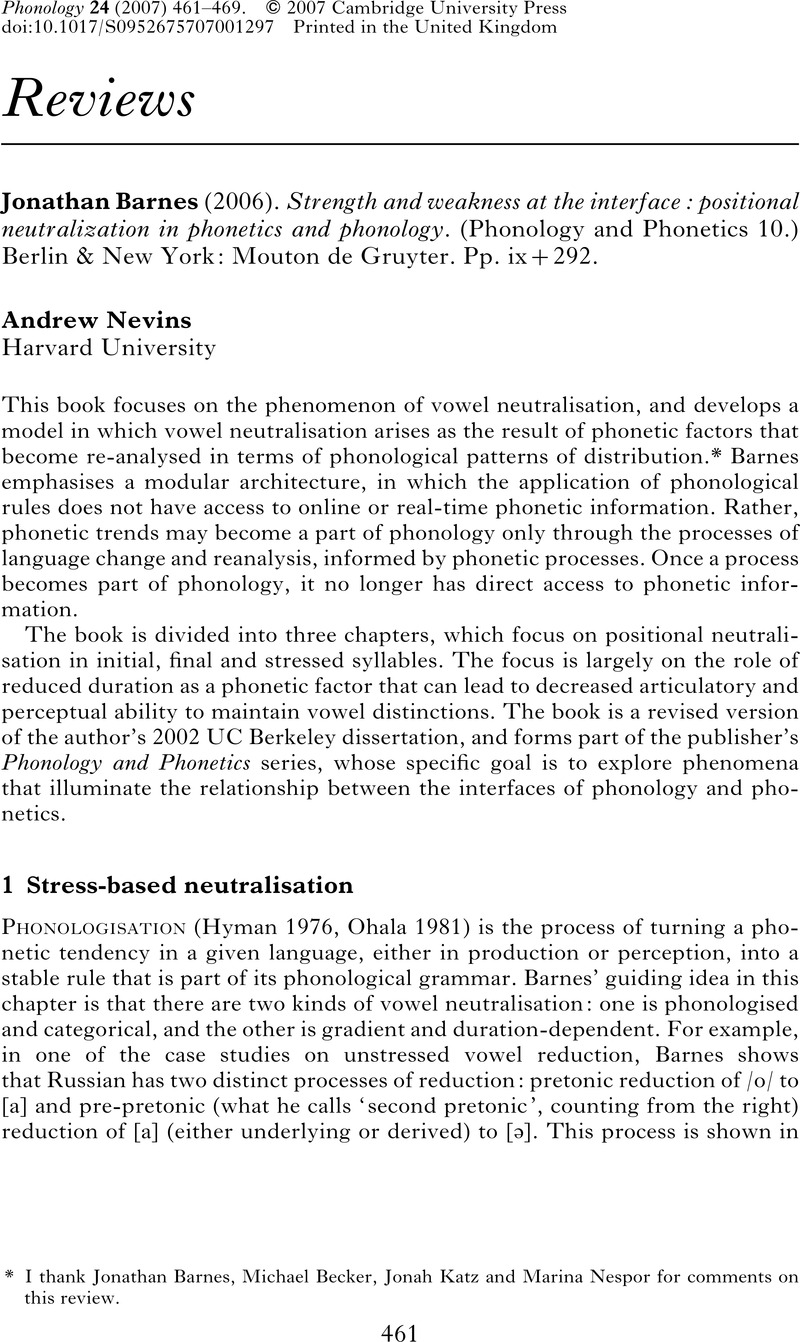No CrossRef data available.
Article contents
Jonathan Barnes (2006). Strength and weakness at the interface: positional neutralization in phonetics and phonology. (Phonology and Phonetics 10.) Berlin & New York: Mouton de Gruyter. Pp. ix+292.
Review products
Jonathan Barnes (2006). Strength and weakness at the interface: positional neutralization in phonetics and phonology. (Phonology and Phonetics 10.) Berlin & New York: Mouton de Gruyter. Pp. ix+292.
Published online by Cambridge University Press: 30 November 2007
Abstract
An abstract is not available for this content so a preview has been provided. Please use the Get access link above for information on how to access this content.

- Type
- Book Review
- Information
- Copyright
- Copyright © Cambridge University Press 2007
References
Becker, Michael, Ketrez, Nihan & Nevins, Andrew (2007). When and why to ignore lexical patterns in Turkish obstruent alternations. Paper presented at the 81st Annual Meeting of the Linguistic Society of America, Anaheim.Google Scholar
Beckman, Jill (1998). Positional faithfulness. PhD dissertation, University of Massachusetts, Amherst.Google Scholar
Cho, Taehong & Jun, Sun-Ah (2000). Domain-initial strengthening as enhancement of laryngeal features: evidence from Korean. CLS 36:1. 31–44.Google Scholar
Crosswhite, Katherine (2001). Vowel reduction in Optimality Theory. New York & London: Routledge.Google Scholar
Dauer, Rebecca M. (1980). The reduction of unstressed high vowels in Modern Greek. Journal of the International Phonetic Association 10. 17–27.CrossRefGoogle Scholar
de Lacy, Paul (2006). Markedness: reduction and preservation in phonology. Cambridge: Cambridge University Press.CrossRefGoogle Scholar
Delattre, Pierre (1966). A comparison of syllable length conditioning among languages. International Review of Applied Linguistics 4. 183–198.CrossRefGoogle Scholar
Fougeron, Cécile & Keating, Patricia A. (1996). Articulatory strengthening in prosodic domain-initial positions. UCLA Working Papers in Linguistics 92. 61–87.Google Scholar
Gordon, Matthew (1998). The phonetics and phonology of non-modal vowels: a cross-linguistic perspective. BLS 24. 93–105.CrossRefGoogle Scholar
Holmer, Arthur J. (1996). A parametric grammar of Seediq. Lund: Lund University Press.Google Scholar
Hyman, Larry M. (1976). Phonologization. In Juilland, A. (ed.) Linguistic studies offered to Joseph Greenberg. Vol. 2. Saratoga, Ca.: Anma Libri. 407–418.Google Scholar
Hyman, Larry M. (1999). The historical interpretation of vowel harmony in Bantu. In Hombert, Jean-Marie & Hyman, Larry M. (eds.) Bantu historical linguistics: theoretical and empirical perspectives. Stanford: CSLI. 235–295.Google Scholar
Konrot, Ahmet (1981). Physical correlates of linguistic stress in Turkish. University of Essex Language Centre Occasional Papers 24. 26–53.Google Scholar
Kowalski, Tadeusz (1929). Karaimische texte im Dialekt von Troki. Krakow: Nakładem Polskiej Akademji Umiejśtności.Google Scholar
Lee, Seung Hwa & de Oliveira, António Marco (2003). Variação inter- e intra-dialetal no Português Brasileiro: um problema para a teoria fonologica. In Oliveira, Dermeval da Hora & Collischonn, Gisela (eds.) Teoria lingüística: fonologia e outros temas. João Pessoa: Editora Universitária. 67–91.Google Scholar
Liphola, Marcelino (2001). Aspects of the phonology and morphology of Shimakonde. PhD dissertation, Ohio State University.Google Scholar
Nespor, Marina, Peña, Marcela & Mehler, Jacques (2003). On the different roles of vowels and consonants in speech processing and language acquisition. Lingue e Linguaggio 2. 203–230.Google Scholar
Nevins, Andrew & Vaux, Bert (2004). Consonant harmony in Karaim. MIT Working Papers in Linguistics 46. 175–194.Google Scholar
Ohala, John (1981). The listener as a source of sound change. In Masek, C. S., Hendrick, R. A. & Miller, M. F. (eds.) Papers from the parasession on language and behavior. Chicago: Chicago Linguistic Society. 178–203.Google Scholar
Oller, D. K. (1973). The effect of position in utterance on speech segment duration in English. JASA 54. 1235–1247.CrossRefGoogle ScholarPubMed
Padgett, Jaye & Tabain, Marija (2005). Adaptive Dispersion Theory and phonological vowel reduction in Russian. Phonetica 62. 14–54.CrossRefGoogle ScholarPubMed
Poppe, Nikolas (1960). Vergleichende Grammatik der Altaischen Sprachen. Vol. 1: Vergleichende Lautlehre. Wiesbaden: Harrassowitz.Google Scholar
Redenbarger, Wayne J. (1981). Articulator features and Portuguese vowel height. Cambridge, Mass: Department of Romance Languages and Literatures, Harvard University.Google Scholar
Shcherba, Lev Vladimirovich (1912). Russkie glasnye v kachestvennom i kolichestvennom otnoshenii. St Petersburg: Tipografiia Erlikh.Google Scholar
Smith, Jennifer (2002). Phonological augmentation in prominent positions. PhD dissertation, University of Massachusetts, Amherst.Google Scholar
Turk, Alice E. & Shattuck-Hufnagel, Stefanie (2000). Word-boundary-related duration patterns in English. JPh 28. 397–440.Google Scholar
Wetzels, W. Leo (1992). Mid-vowel neutralization in Brazilian Portuguese. In Abaurre, Bernadete & Wetzels, Leo W. (eds.) Fonologia do Português. Campinas: University of Campinas. 19–55.Google Scholar
Wightman, Colin W., Shattuck-Hufnagel, Stefanie, Ostendorf, Mari & Price, Patti J. (1992). Segmental durations in the vicinity of prosodic phrase boundaries. JASA 91. 1707–1717.CrossRefGoogle ScholarPubMed


